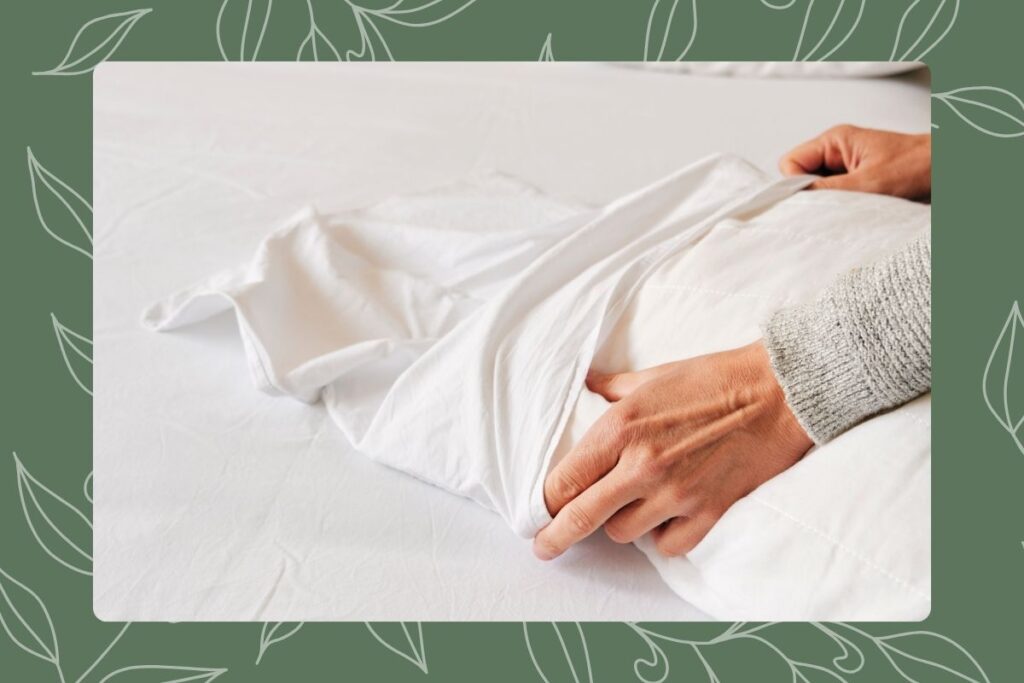The Impact of Your Pillowcase on Your Skin

Key Takeaways
- Pillowcases collect oils, sweat, and bacteria that can clog pores and trigger breakouts.
- Rough fabrics increase friction, which may contribute to wrinkles and hair damage over time.
- Changing your pillowcase every 2–3 days can help reduce acne and skin irritation.
- Materials like silk, bamboo, and antimicrobial fabrics are gentler and better for sensitive or acne-prone skin.
Every night, we lay our heads on our pillowcases, not thinking much about their impact on our skin health. But could these apparently harmless pieces of fabric be the hidden culprits behind some common skin issues? This blog post delves into the surprising ways your pillowcase could be affecting your skin and your hair. We’ll also cover how often you should change your pillowcase and what materials are best for your skin.
How Can Your Pillowcase Affect Your Skin?
Your pillowcase collects a lot of things you’d rather not think about: sweat, dead skin cells, natural hair oils, leftover makeup, and even residue from hair products. When your face is pressed against your pillowcase for hours every night, these accumulations can affect your skin in several ways:
Acne
Pillowcases can harbor bacteria and oils, which can clog pores and lead to breakouts. If you’re acne-prone, your pillowcase could be exacerbating the issue, especially if it’s not changed frequently.
Wrinkles
While it’s a normal part of aging, how you sleep can influence the formation of wrinkles. Rough materials can tug at your skin and cause creasing. Over time, these crease lines can become permanent, especially if you’re always sleeping on the same side.
Rashes
Sensitive skin can react to the buildup of laundry detergent residues or the fabrics themselves, leading to irritation or allergic reactions. If you notice your skin is itchier or more irritated in the morning, your pillowcase could be the culprit.
Hair
Your pillowcase can affect your hair health, causing damage and influencing oil balance. Friction from rough fabrics like cotton can lead to breakage and tangling. Additionally, pillowcases accumulate oils, product residues, and sweat, which can transfer back to your hair and scalp, potentially causing dryness or oiliness.
How Often Should You Change Your Pillowcase?
Dermatologists recommend changing your pillowcase at least once a week. However, if you have oily skin or sweat a lot at night, you might want to change it even more frequently. For acne-prone individuals, using a fresh pillowcase every two to three days can significantly help manage breakouts.
What Types of Pillowcase Materials Are Best?
Cotton
Cotton is breathable and soft, but it might not be the best choice for everyone. It absorbs moisture, which can be beneficial for keeping oils off your face, but it also means it can harbor bacteria.
Silk
Silk pillowcases are gentle on the skin and hair. They don’t absorb as much moisture as cotton, which helps keep your skincare products on your face, not your pillow. Silk also reduces friction, which can help prevent wrinkles and hair breakage.
Antimicrobial Fabrics
Some pillowcases are made from materials treated with or made from antimicrobial substances. These can be particularly beneficial for acne-prone skin as they help keep the bacterial population in check.
Hypoallergenic Materials
For those with sensitive skin, hypoallergenic pillowcases made from bamboo or other gentle fibers can reduce irritation and allergic reactions.
The Power of a Pillowcase
Never underestimate the power of a clean pillowcase to improve your skin health. By choosing the right material and changing your pillowcase regularly, you can significantly reduce the risk of acne, wrinkles, rashes, and hair damage. It’s a simple step, but it can make a big difference in your skin’s health and appearance. So, give your skin the fresh, clean environment it needs to thrive and start paying attention to your pillowcase tonight!
FAQs
How does a pillowcase contribute to acne?
Pillowcases can significantly contribute to acne for a couple of reasons. First, they absorb oils, sweat, and dead skin cells from your face and hair. Over time, these residues build up and can clog pores, creating a breeding ground for bacteria that cause acne. If the pillowcase is not changed frequently, this accumulation becomes more substantial, increasing the risk of breakouts, particularly for those who are already prone to acne. Dermatologists often recommend using a fresh pillowcase every two to three days to help manage and reduce acne.
Can the type of pillowcase I use affect the formation of wrinkles?
Yes, the type of pillowcase you use can affect the formation of wrinkles. Rough pillowcase materials, like standard cotton, can tug at your skin and create friction as you move in your sleep. This friction can cause the skin to fold and crease, potentially leading to “sleep lines.” Over time, these sleep lines can turn into permanent wrinkles, especially if you consistently sleep on the same side of your face. Using silk pillowcases can help mitigate this issue, as silk causes less friction and thus is gentler on the skin, reducing the likelihood of forming wrinkles.
Are there specific pillowcase materials recommended for sensitive skin?
Yes, individuals with sensitive skin should consider using hypoallergenic pillowcase materials to minimize irritation. Materials such as bamboo, silk, and specially treated hypoallergenic fabrics are advisable because they are softer and less likely to provoke skin reactions. Bamboo and silk, in particular, are naturally hypoallergenic and have smoother surfaces that reduce friction and irritation. Additionally, these materials are less likely to harbor bacteria and dust mites, common irritants for sensitive skin. Choosing the right pillowcase material can help alleviate discomfort and improve overall skin health for those with sensitive skin conditions.
